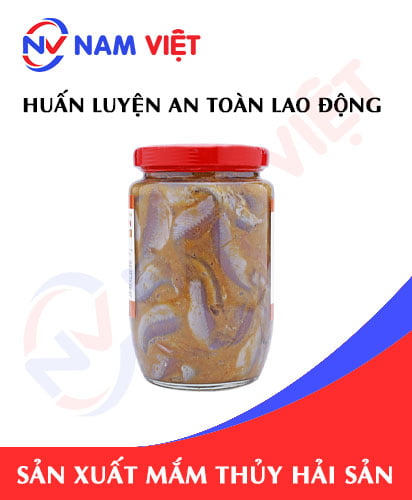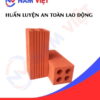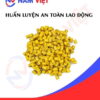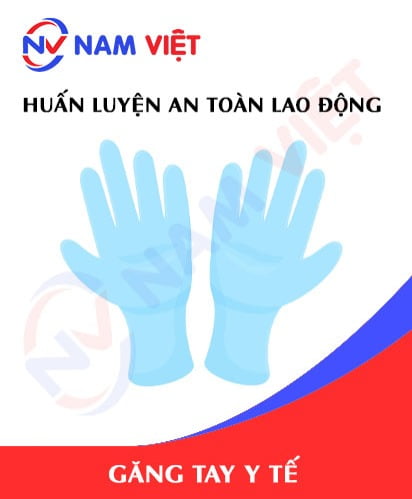Occupational safety training for seafood fermented paste manufacturing
99,000 ₫
Note: The above price is calculated per person; prices may vary depending on the number of trainees participating in the course and market fluctuations. For more accurate pricing support, please refer to the pricing table or contact our consultants directly.
Occupational safety is an important issue in seafood fermented paste manufacturing factories and needs to be addressed promptly to ensure the health and safety of workers, enhancing the reputation of businesses. The Occupational Safety Training course is one of the effective solutions to raise awareness about preventing occupational accidents for workers involved in seafood fermented paste manufacturing.
Table of Contents
Toggle1. Overview of seafood fermented paste
a. What is seafood fermented paste?
- Seafood fermented paste is a type of fermented paste processed from seafood such as fish, shrimp, crab, squid, clams, mussels, snails, etc., through the fermentation process of sugar, salt, and seafood in a container. This fermentation process helps the seafood decompose and produce organic acids, creating the characteristic flavor of seafood fermented paste. Seafood fermented paste is widely used in the cuisine of Asian countries, especially Vietnam.
- The seafood fermented paste manufacturing industry in Vietnam is developing and has great potential, especially in many coastal areas. The common types of seafood fermented paste manufactured in Vietnam include linh fish paste, anchovy paste, sặc fish paste, tuna paste, shrimp paste, crab paste, mackerel paste, stingray paste, and fresh fish paste.
- The famous localities for manufacturing seafood fermented paste in Vietnam include Phan Thiet, Nha Trang, Quy Nhon, Ha Long, Phu Quoc, Can Tho, Vung Tau, and Ca Mau.

b. Types of machinery for seafood fermented paste manufacturing
Machinery for seafood fermented paste manufacturing does not involve complex technology. Typically, the machinery in the seafood fermented paste manufacturing process are simply supporting devices for processing, including:
- Processing equipment: grinder, press, sieve, mixer,…
- Fermentation equipment: fermentation tank, fermentation barrel, fermentation box,..
- Quality control equipment: pH meter, salinity meter,..
- Packaging equipment: packaging machine, sealing machine,..
- Preservation equipment: freezer, storage warehouse,..
Depending on the manufacturing scale, manufacturers will choose appropriate equipment to ensure the manufacturing process and product quality.

c. Typical seafood fermented paste manufacturing companies in Vietnam
Some typical seafood fermented paste manufacturing companies in Vietnam include:
- Con Dong Hai Fermented Paste Manufacturing and Trading Co., Ltd.
- Khanh Hoa Fermented Paste Manufacturing Single Member Co., Ltd.
- Ham Luong Fermented Paste Manufacturing and Trading Co., Ltd.
- Ha Noi Fermented Paste Joint Stock Company
- Ninh Hoa Fermented Paste Joint Stock Company
- Nha Trang Seahorse Fermented Paste Co., Ltd.
- Bien Xanh Shrimp Paste Co., Ltd.
- Nha Trang Fermented Paste Manufacturing and Trading Co., Ltd.
- Soc Trang Shrimp Paste Manufacturing and Trading Co., Ltd.
- Tan Phu Shrimp Paste Joint Stock Company
These are some of the well-known and reputable seafood fermented paste manufacturing companies in the Vietnamese market.
d. Specific jobs in a seafood fermented paste manufacturing factory
Group 1
- Executive director, deputy executive director, and department head in the seafood fermented paste manufacturing factory.
Group 2
- Safety officer: manages safety in the factory, designs safety procedures, supervises and urges employees to comply with safe work procedures.
Group 3
- Raw material selection: The main raw materials for seafood fermented paste manufacturing are various types of fish, shrimp, crab, squid, and other seafood. The raw materials must be carefully selected to ensure the quality of the final product.
- Raw material processing: After selecting the raw materials, they will be processed to remove unnecessary parts and prepare for the fermentation process.
- Fermentation: The fermentation process is the main process for creating seafood fermented paste. This process needs to ensure factors such as temperature, humidity, pH, and salinity to produce a high-quality product.
- Packaging: After the fermentation process is completed, the seafood fermented paste will be packaged for preservation and consumption.
- Quality control: During the manufacturing process, quality control must be carried out regularly to ensure that the final product meets the requirements for quality and food safety.
- Food safety and hygiene: This is a crucial job to ensure food safety and hygiene during the seafood fermented paste manufacturing process. Employees must comply with hygiene regulations, use protective equipment, and clean equipment, machinery, and work areas to prevent contamination and infection of the product.
Group 4
- Jobs in the office, service, sales, and marketing.
- Production management, quality management, human resource management, material management, financial accounting management.
- Research and development of new products, product packaging design.

e. Popular types of seafood fermented paste
The popular types of seafood fermented paste on the market include:
- Shrimp paste: made from dried shrimp, live shrimp, or shrimp powder, with a fragrant and sweet taste.
- Fish paste: there are many types such as linh fish paste, stingray paste, mackerel paste, anchovy paste, tuna paste, mackerel paste… Fish paste has a rich flavor, often used to dip raw vegetables, crackers, mix with vermicelli, pho, or wrap in spring rolls…
- Crab paste: has a rich, slightly sour taste, often used to marinate meat, wrap rice paper, or dip with raw vegetables.
- Snail paste: has a rich flavor, often used to dip rice paper, eat with raw vegetables, or marinate meat.
- Oyster paste: has the characteristic taste of oysters, often used to eat with raw vegetables or as a dipping sauce.
Other types of seafood fermented paste are also manufactured and distributed on the market depending on the region and consumer preferences.
2. Overview of occupational safety training for seafood fermented paste manufacturing
Within the scope of this article, we focus on issues surrounding Group 3, because Group 3 is the group directly participating in the manufacturing process, bearing the highest risk of occupational accidents. See more about other groups here
a. What is Group 3 occupational safety training?
- Occupational safety training for Group 3 are sessions that provide awareness on how to prevent occupational accidents for employees.
- The occupational safety training course will help employees recognize and avoid dangers, and limit the risks of occupational accidents while working.
REGISTER FOR OCCUPATIONAL SAFETY TRAINING SERVICES
b. Training duration
Initial safety training duration
- The total training duration is at least 24 hours, including the time for testing.
- 8 hours of theoretical study on the system of policies and laws on occupational safety and health
- 8 hours of theoretical study on basic knowledge of occupational safety and health
- 4 hours of theoretical study on specialized training content
- 2 hours of practical training on specialized training content
- 2 hours of theoretical testing at the end of the training course
The safety training center will divide the time into several training sessions depending on the time arrangement for employees. However, there are usually 6 training sessions, and the course will last for 3 days, provided that the manufacturing company can arrange continuous study time.
Periodic safety training duration
- Before the safety card expires, if employees want to have it reissued, they must undergo a periodic occupational safety training course, with the periodic safety training duration being at least 50% of the initial safety training duration.
Explanation: The total duration of periodic occupational safety training is at least 12 hours, including the time for testing. After completing the periodic training course and passing the test, the employee will be re-issued or have their safety card renewed.
c. Content of the training course
| No. | TRAINING CONTENT | TRAINING DURATION (HOURS) | |||
| Total | Of which | ||||
| Theory | Practical | Test | |||
| I | System of policies and laws on occupational safety and health | 8 | 8 | 0 | 0 |
| 1 | Overview of the system of legal normative documents on occupational safety and health. | 6 | 6 | ||
| 2 | System of technical standards and regulations on occupational safety and health. | 1 | 1 | ||
| 3 | Specific regulations of state management agencies on occupational safety and health when newly building, expanding, or renovating works, facilities for manufacturing, using, preserving, storing, and inspecting machinery, equipment, materials, and substances with strict requirements for occupational safety and health. | 1 | 1 | ||
| II | Basic knowledge of occupational safety and health | 8 | 8 | 0 | 0 |
| 1 | Basic knowledge of dangerous and harmful factors at the workplace. | 4 | 4 | ||
| 2 | Methods for improving working conditions. | 1 | 1 | ||
| 3 | Safety culture in manufacturing and business. | 1 | 1 | ||
| 4 | Rights and obligations of the employer, the employee; policies and regimes on occupational safety and health for employees; functions and duties of the network of safety and health officers. | 1 | 1 | ||
| 5 | Occupational safety and health regulations, signs, safety instructions, and the use of safety equipment, personal protective equipment; professional skills and first aid for occupational accidents, prevention of occupational diseases. | 1 | 1 | ||
| III | Specialized training content | 6 | 4 | 2 | 0 |
| Comprehensive knowledge of types of machinery, equipment, and substances that generate dangerous and harmful factors; analysis, assessment, and management of risks related to occupational safety and health, safe working procedures with machinery, equipment, and substances with strict requirements for occupational safety and health. | 6 | 4 | 2 | ||
| IV | Occupational safety training test at the end of the training course | 2 | 2 | 0 | 0 |
| Total | 24 | 22 | 2 | ||
See more training content for 6 groups
d. Occupational safety card
After completing the occupational safety training course and passing the test, the employee will be issued an occupational safety card (also commonly known as a Group 3 occupational safety certificate).
The Group 3 safety card will clearly show information such as: full name, date of birth, specific job, and working environment. It also includes the training duration, a red seal, and a signature confirming the completion of the training course.
According to the regulations on issuing safety cards specified in clause 2 article 24 of decree 44/2016/ND-CP, there are two cases:
- In the case where the employer and the employee have an employment contract, the employer must sign, seal, and interleaf the safety card for the trained Group 3 employee after they have completed the training course from the occupational safety training unit and passed the test.
- In the case of a freelance or seasonal worker who does not have an employment contract, the training unit must sign, seal, and interleaf the safety card for the employee after they have completed the training course from the occupational safety training unit and passed the test.

3. Identifying hazards affecting employees during seafood fermented paste manufacturing
The manufacturing of seafood fermented paste can pose many potential dangers to the health and safety of employees, such as:
- During the seafood fermented paste manufacturing process, chemicals such as acids, bases, nitrites, sodium salts, potassium… are used. When used incorrectly, they can pose a health hazard to employees.
- The manufacturing of seafood fermented paste requires a humid and high-temperature working environment, especially during the fermentation process. These conditions can cause some health problems for employees such as dermatitis, skin infections, arthritis, and diabetes.
- Since seafood fermented paste is manufactured from fresh seafood, if the manufacturing process is not carried out correctly and with proper hygiene measures, it can lead to a risk of infection for employees.
- The use of machinery and manufacturing equipment can cause occupational accidents if safety procedures and accident prevention measures are not properly followed.
- If the electrical equipment in the factory is not regularly maintained, sufficiently insulated, or waterproofed, it will pose a risk of electric shock to employees during the manufacturing process.
4. Common types of occupational accidents for employees during seafood fermented paste manufacturing
The occupational accidents that commonly occur during the manufacturing of seafood fermented paste may include:
- Injuries from knives, cuts, tears: When processing seafood such as shrimp, crab, and snails, employees can be injured by knives, cutters, and other cutting tools.
- Falls: Employees often have to move in a humid, slippery environment, especially when packaging seafood fermented paste on high floors, risking falls, which can cause serious injuries.
- Food poisoning: During the manufacturing of seafood fermented paste, chemicals and preservatives can lead to food poisoning for employees.
- Chemical poisoning: Employees can be poisoned by chemicals when spraying preservatives or pesticides.
- Eye injuries: The processing of seafood fermented paste creates a lot of dust and steam, causing eye injuries, difficulty breathing, and respiratory problems.
5. Safety measures for participating in seafood fermented paste manufacturing
To ensure the safety of employees during the seafood fermented paste manufacturing process, the following safety measures need to be implemented:
- Equip employees with full personal protective equipment, including: masks, safety glasses, gloves, cleanroom suits, safety shoes, hard hats, face masks, respirators, etc.
- A ventilation and exhaust system to ensure the air in the factory is always well-ventilated and clean.
- Use chemicals that are safe, compliant with state regulations, and not harmful to employees’ health.
- Ensure that manufacturing equipment, machinery, and tools are maintained, repaired, and inspected periodically, especially machinery related to cooking paste and treating toxic gases.
- Train and instruct employees on occupational safety measures, how to use protective equipment, and fire and explosion prevention measures.
- Increase supervision and periodic inspection to detect and promptly remedy hazards that may occur during the manufacturing process.
- Ensure food hygiene and safety for seafood fermented paste products, including quality control of raw materials, manufacturing water, and maintaining hygiene during the manufacturing, packaging, and storage of products.
- Periodically organize work environment monitoring in factories and enterprises, collect and analyze harmful factors for employees, and then adjust to reduce the level of harm to prevent occupational diseases for them.

6. Benefits of occupational safety training for seafood fermented paste manufacturing
An Toan Nam Viet provides your business with wonderful benefits after completing the occupational safety training courses as regulated in Decree 44/2016/ND – CP on occupational safety and health work, for companies, factories, and enterprises.
- Employees can recognize potential risks of occupational accidents, thereby having preventive measures to avoid accidents.
- Your business can establish risk prevention measures in the manufacturing, operation, and maintenance processes.
- Minimize costs when safety risks occur in the workplace.
- Uninterrupted manufacturing will help increase labor productivity and product quality.
- Comply with occupational safety laws, avoiding legal risks.
- Create prestige and professionalism in all aspects, thereby enhancing your business’s brand.
Nam Viet’s training courses are the solution to prevent and combat external factors affecting each individual so that they can avoid danger that can lead to injury or, more seriously, death.
REGISTER FOR OCCUPATIONAL SAFETY TRAINING SERVICES
7. Customer feedback after completing the occupational safety training course for seafood fermented paste manufacturing
An Toan Nam Viet has many years of experience in the mission of accompanying many businesses in Vietnam in general and in the southern provinces in particular. And that responsibility is something very precious to Nam Viet, which is why Nam Viet’s Occupational Safety Training work is increasingly focused on becoming more professional. And the motivation for An Toan Nam Viet to develop strongly to this day comes from the positive feedback and suggestions from businesses. Below are the responses from our partners that we have served.
Bac Nam E&C Construction and Investment Joint Stock Company
“The first time I used the service at An Toan Nam Viet, I was very surprised by the enthusiastic 24/7 support of the consulting team. The class organization was very fast and convenient for our company, thank you very much for Nam Viet’s service!”
Hoa Dat Construction and Trading Joint Stock Company
“Nam Viet’s service has helped us a lot in simplifying occupational safety and the work of completing safety records for the work process. The consulting team is enthusiastic and timely in answering our questions. 5 stars for Nam Viet”
See more customer interviews after using An Toan Nam Viet’s services
8. An Toan Nam Viet’s occupational safety training capacity
An Toan Nam Viet is a reputable and high-quality occupational safety training center in Vietnam today. With continuous occupational safety training sessions taking place at manufacturing workshops, factories or construction sites across the country (63 provinces and cities in Vietnam).
REGISTER FOR OCCUPATIONAL SAFETY TRAINING SERVICES
Occupational safety training license
- An Toan Nam Viet has been inspected and certified by the Department of Occupational Safety under the Ministry of Labor – Invalids and Social Affairs as qualified to operate in occupational safety and health training. This further strengthens our capacity for occupational safety training.

Documents and lectures
- Before occupational safety training documents are included in occupational safety training courses, they are reviewed and approved to ensure that the lectures are accurate in terms of knowledge and effective when applied.
- The teaching method of the lecturers is standardized according to the teaching standards of An Toan Nam Viet, which is a method that experts in occupational safety and health training have researched and summarized during the teaching process to bring the highest knowledge acquisition efficiency to students.
Facilities
- Controlling the factors in the classroom that affect the training process will increase teaching performance and the effectiveness of knowledge acquisition for students.
- Our training facilities always arrange spacious classrooms that meet standards for area, lighting, training equipment … etc…
9. Reputable and high-quality safety training center nationwide
At An Toan Nam Viet, we always prioritize our professional dedication to occupational safety training. For us, conveying knowledge on how to protect oneself to workers so that they can have a safe journey on their path to earning a living is a contribution to building the country.
To ensure effective training, we meticulously prepare every little thing, no matter how small. From preparing tools, equipment, and teaching devices to textbooks, documents, sound, and lighting.
Our occupational safety training lecturers are experts with many years of experience in the field. They even have research projects identifying hazards in all occupations and how to prevent them.
The lecturers’ lessons are distilled from practice and are conveyed in the most vivid and easy-to-visualize way to the workers. These factors help workers feel comfortable during their study time and absorb our teaching knowledge well. Of course, the knowledge conveyed always closely follows Decree 44/2016/ND-CP.
From there, they grasp many measures to prevent danger and how to protect themselves. At the same time, they also apply it in the most appropriate way in their actual work.
Our safety training center is proud to be a reputable and professional provider of occupational safety training services with the following advantages:
- Competitive training costs but training quality is still guaranteed.
- Flexible training schedule to suit the production situation of companies and businesses.
- Fast occupational safety training certificate application process, in accordance with legal regulations.
- The training lecturers are those with many years of experience in the profession.
- The classroom environment is controlled for factors that affect the training process, increasing teaching performance and the effectiveness of knowledge acquisition for students.
- The lectures are compiled to be suitable for occupational safety work at businesses.
- An Toan Nam Viet works with dedication and professionalism to support customers accurately and quickly.

10. See more occupational safety training documents for seafood fermented paste manufacturing
- Occupational safety documents for seafood fermented paste manufacturing
- Set of occupational safety training documents
- Set of occupational safety training test questions
- Occupational safety multiple-choice test for seafood fermented paste manufacturing
- Slides for occupational safety training lectures for seafood fermented paste manufacturing
1 review for Occupational safety training for seafood fermented paste manufacturing
No comments yet















namchinh.haiphong341
Giảng viên dạy rất sinh động dễ hiểu!